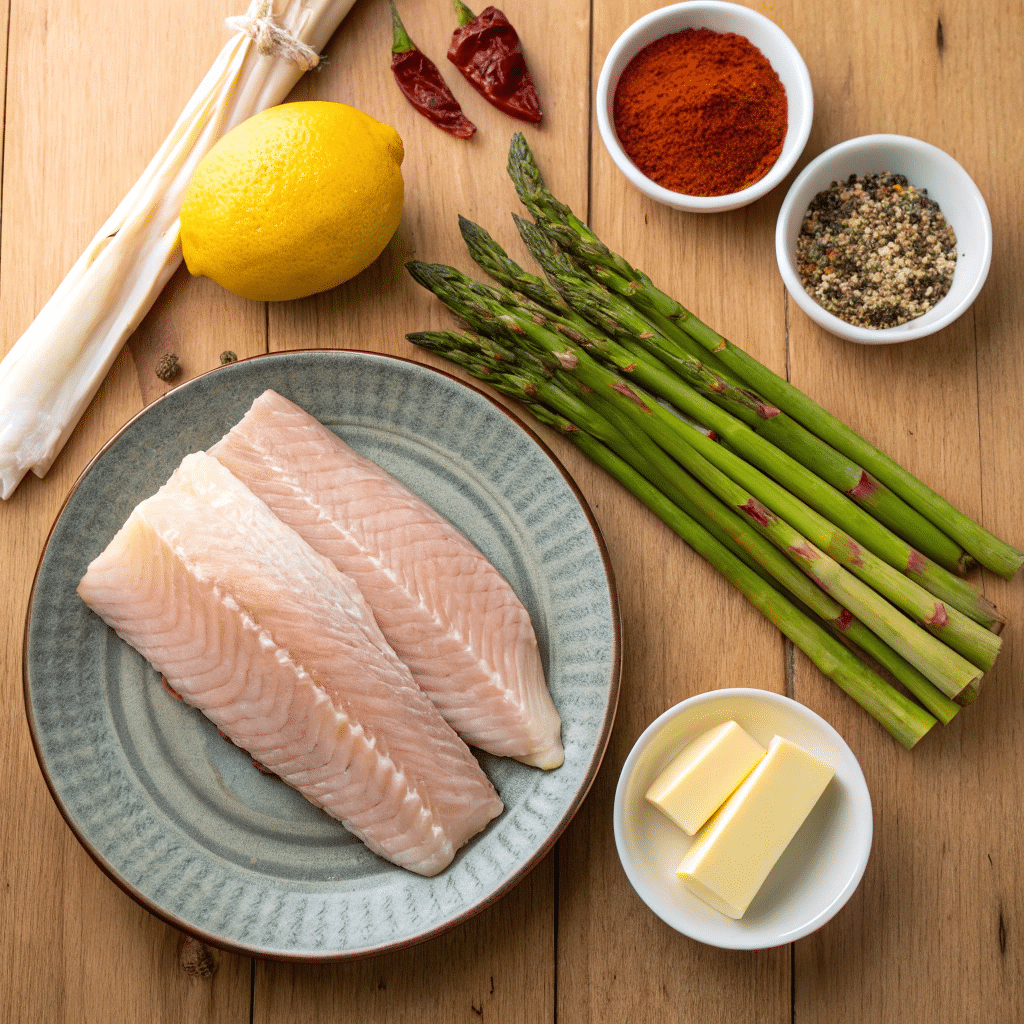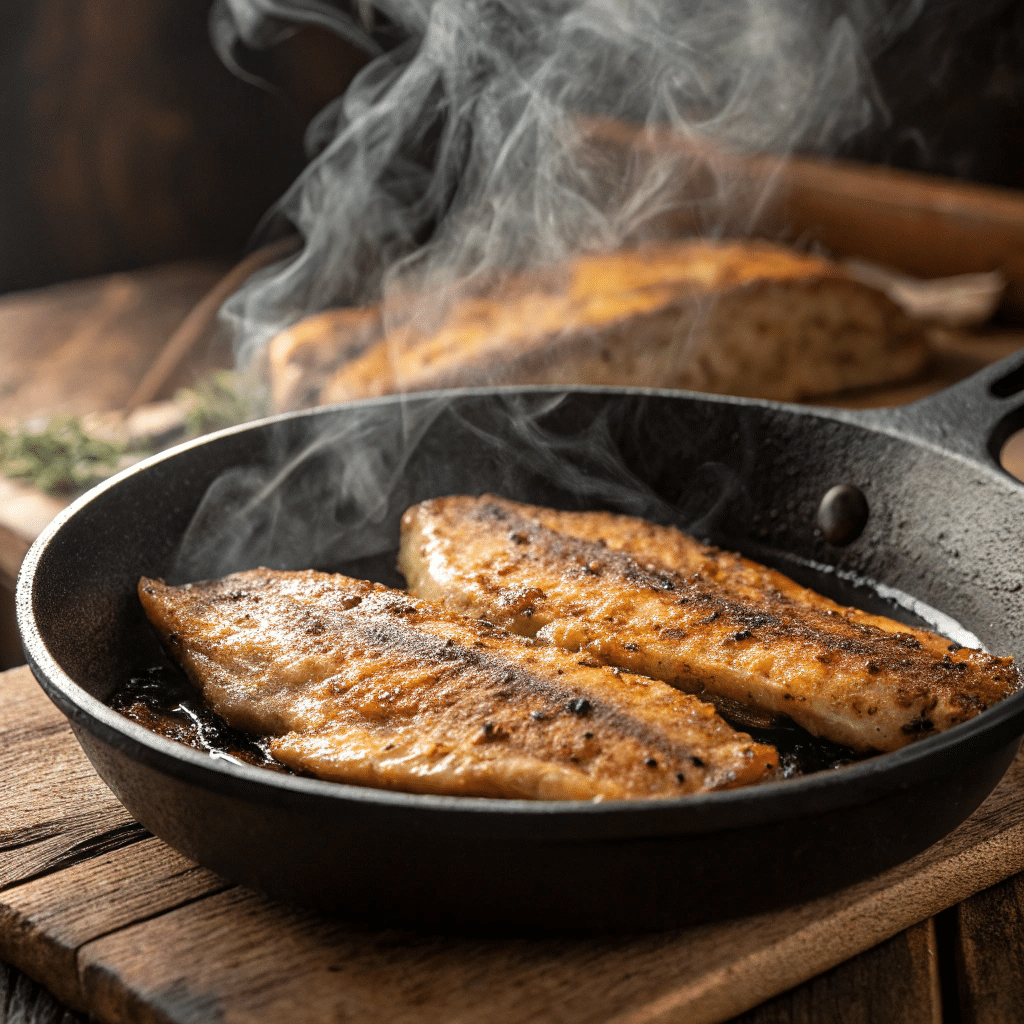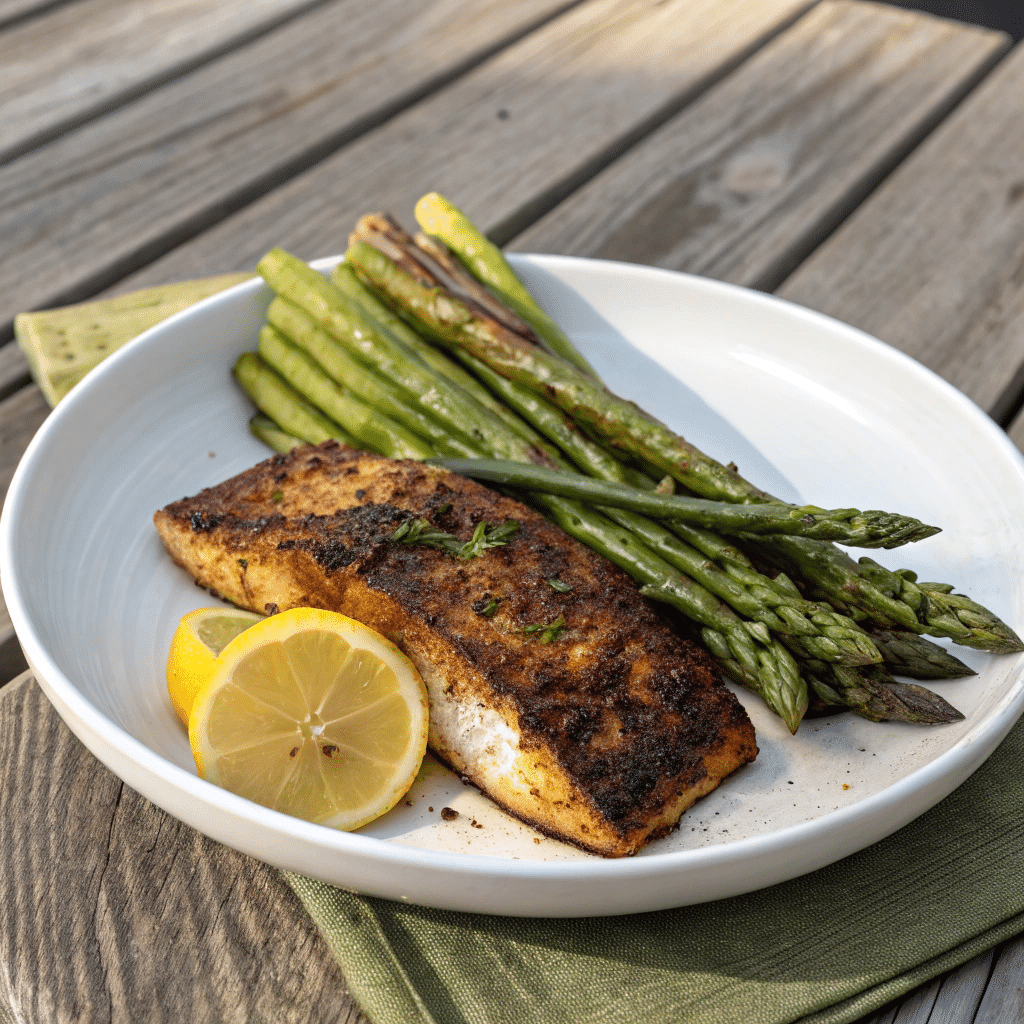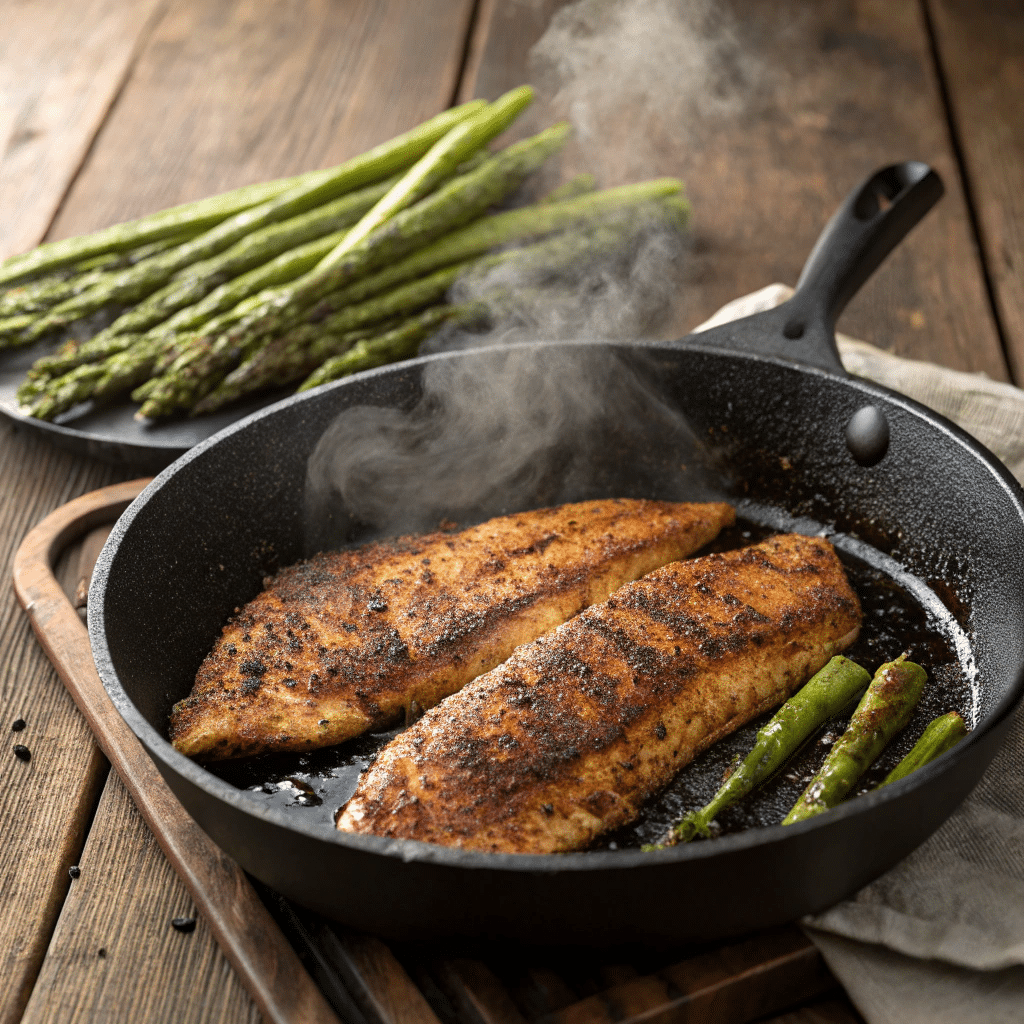Introduction
This recipe for blackened catfish with asparagus is a perfect weeknight dinner idea for flavor lovers.
Whether you’re cooking for one or feeding the whole family, this recipe delivers big flavor in a short amount of time.
If your kitchen has ever turned into a smoke-filled experiment zone (no shame, it happens), then blackened catfish might just be your next favorite meal. This dish brings heat, flavor, and that deep crispy crust—all balanced out by the fresh snap of asparagus. In this post, you’ll discover exactly how to make blackened catfish with asparagus in a single pan without fancy tools or complicated steps. Whether you’re cooking for one or feeding the whole family, this recipe delivers big flavor in a short amount of time. What Is Blackened Catfish with Asparagus?
Origins of blackened seasoning
Blackened seasoning became popular in the 1980s thanks to Chef Paul Prudhomme in Louisiana. The cooking method involves coating meat or fish in a bold spice blend and searing it quickly in a very hot skillet. The result? A dark, flavorful crust that locks in moisture and adds a smoky kick. It’s bold, Southern, and totally addictive.
Catfish, being a staple in Southern U.S. cooking, pairs beautifully with this method. It holds up well to high heat and absorbs spices like a champ. Combined with blackening techniques, it transforms from mild to magical. When paired with fresh vegetables like asparagus, blackened catfish with asparagus becomes a complete, balanced meal rooted in Southern flavor.
Why catfish and asparagus make a perfect match
At first glance, it might seem like a strange combo—fatty Southern fish with a veggie that’s usually seen in spring brunch dishes? But that’s the beauty of it. Asparagus brings a crisp, grassy bite that balances the smoky, spicy richness of blackened catfish. Plus, both ingredients cook quickly and thrive in a skillet.
This duo also works beautifully in terms of texture. The flakiness of the fish and the snap of roasted asparagus create a bite that’s both satisfying and light. It’s the kind of combo that makes your dinner feel fancy without the fuss.
That’s why blackened catfish with asparagus is such a smart and flavorful dinner choice.
Ingredients You’ll Need for Blackened Catfish with Asparagus
Key Ingredients for the Blackened Catfish
To make the perfect blackened catfish with asparagus, start by gathering the essential ingredients
You don’t need a grocery list a mile long to make this dish. Here’s what you’ll need for that bold flavor:
- Catfish fillets (fresh or thawed) – 2 to 4 fillets, skinless if possible
- Paprika (smoked or sweet) – for color and earthy depth
- Garlic powder & onion powder – savory flavor builders
- Dried thyme and oregano – bring out that Cajun soul
- Cayenne pepper & black pepper – for heat and balance
- Salt – to enhance every bite
- Unsalted butter or neutral oil – helps develop that crispy crust
Optional but highly recommended: squeeze of lemon for brightness after cooking.
Choosing and Preparing the Asparagus
Since it’s part of the star duo, preparing the asparagus correctly is just as important in this blackened catfish with asparagus dish.
Asparagus is more than just a side here—it’s a co-star. To prep it right:
- Look for firm, bright green stalks with tightly closed tips
- Snap off the woody ends (they’ll naturally break where they’re too tough)
- Toss in a little olive oil, salt, and cracked pepper before cooking
The goal is to get a crisp-tender bite—not mushy or overdone. If you like a bit of char on your veggies (who doesn’t?), let them sit undisturbed in the pan for a minute or two while cooking.
Ingredients You’ll Need for Blackened Catfish with Asparagus
Key Ingredients for the Blackened Catfish
You don’t need a grocery list a mile long to make this dish. Here’s what you’ll need for that bold flavor:
- Catfish fillets (fresh or thawed) – 2 to 4 fillets, skinless if possible
- Paprika (smoked or sweet) – for color and earthy depth
- Garlic powder & onion powder – savory flavor builders
- Dried thyme and oregano – bring out that Cajun soul
- Cayenne pepper & black pepper – for heat and balance
- Salt – to enhance every bite
- Unsalted butter or neutral oil – helps develop that crispy crust
- Optional but highly recommended: squeeze of lemon for brightness after cooking.
Choosing and Preparing the Asparagus
Asparagus is more than just a side here—it’s a co-star. To prep it right:
- Look for firm, bright green stalks with tightly closed tips
- Snap off the woody ends (they’ll naturally break where they’re too tough)
- Toss in a little olive oil, salt, and cracked pepper before cooking
The goal is to get a crisp-tender bite—not mushy or overdone. If you like a bit of char on your veggies (who doesn’t?), let them sit undisturbed in the pan for a minute or two while cooking.
If you’re missing some ingredients, don’t worry. Here are smart substitutions that still deliver great flavor:
| Ingredient | Substitute |
|---|---|
| Catfish | Tilapia or Cod |
| Butter | Avocado Oil |
These swaps are especially helpful if you’re cooking for someone with dietary preferences or working with pantry staples.

Step-by-Step Instructions for Cooking Blackened Catfish with Asparagus
Let’s dive into how to make blackened catfish with asparagus from start to finish.
How to Cook Blackened Catfish Without Overcooking
Cooking catfish the blackened way is all about heat and confidence. Here’s how to nail it:
- Pat the catfish dry with paper towels — moisture is the enemy of a good crust.
- Coat both sides generously with your blackening spice mix.
- Heat a cast iron skillet over medium-high heat until it’s smoking slightly.
- Add a spoon of butter or neutral oil, swirl to coat the pan.
- Carefully lay the fillets down — they should sizzle loud.
- Cook undisturbed for 2–3 minutes per side, depending on thickness.
- Flip only once. You want a dark crust, not a soggy one.
The fish is done when it flakes easily with a fork and the inside is opaque. If the crust is too black, you likely had the heat too high or left it too long.
The Right Way to Pan-Roast Asparagus
Getting the timing right ensures that the blackened catfish with asparagus finishes perfectly together.
Timing the asparagus right means it finishes with the fish — and doesn’t go limp.
- In a separate pan (or after the catfish), heat olive oil over medium.
- Add the trimmed asparagus and a pinch of salt.
- Let it sit for 1–2 minutes without stirring — this gives it some char.
- Toss it gently, then cook for another 3–4 minutes until crisp-tender.
If you’re in a rush, throw it in the oven with a drizzle of oil and roast at 425°F for 8–10 minutes. You’ll still get great results.

Tips for Blackening Without Drying Out the Fish
Keep the Fish Moist While Building That Crust
- Don’t overcook. Catfish is a thin, fast-cooking fish. 2–3 minutes per side is usually enough.
- Use enough fat. Butter or oil not only prevents sticking but also helps the spices toast—not burn.
- Let it rest. After cooking, wait 2–3 minutes before cutting or serving. This keeps juices from running out.
- Don’t crowd the pan. If you’re cooking more than two fillets, do it in batches. Crowding = steam = soggy crust.
These tips guarantee your blackened catfish with asparagus turns out restaurant-quality every time.
That’s the secret behind nailing blackened catfish with asparagus—even on your busiest nights.
When to Add Butter (And When Not To)
Butter gives flavor, but it burns fast. Use a combination of high-smoke-point oil (like avocado or grapeseed) and a dab of butter:
- Add oil first, then butter right before placing the fish.
- If you want more butter flavor, baste the fish with melted butter after flipping.
- Avoid adding butter too early if your heat is very high—it’ll burn and smoke too much.
These little tweaks keep your blackened crust tasty without crossing into burnt territory.
Flavor Pairings and Simple Side Ideas
What Goes Well with Blackened Catfish?
The bold, spicy flavor of blackened catfish calls for this makes blackened catfish with asparagus a perfect pairing for quick, balanced dinners When served alongside asparagus, blackened catfish creates a well-balanced, restaurant-style plate side dishes that balance and complement it. Here are a few tried-and-true options:
- Roasted garlic mashed potatoes – Creamy and mellow, they help soften the heat of the blackened spices.
- Cornbread or Southern-style biscuits – Slightly sweet and crumbly, they pair perfectly with smoky seafood.
- Vinegar-based coleslaw – Adds a tangy crunch that cuts through the richness.
- Cajun rice or dirty rice – Carries similar seasoning, tying the whole plate together.
These sides are quick to prepare and elevate the dish without stealing the spotlight.
Why Asparagus Is the Perfect Match
Asparagus doesn’t just add color—it’s a smart pairing for blackened catfish. Here’s why:
- Earthy and slightly bitter – It creates a natural contrast to the rich, spicy coating on the fish.
- Quick cooking time – Like catfish, it doesn’t need long in the pan, making weeknight meals fast.
- Takes seasoning well – Whether grilled or sautéed, asparagus absorbs flavor while staying crisp.
Add a squeeze of lemon or a sprinkle of parmesan to bring it all together.
Adapting the Recipe for Special Diets
Making It Low-Carb or Keto-Friendly
Blackened catfish with asparagus is already a great fit for low-carb and keto diets, but here are a few simple ways to optimize it further:
- Skip sugary spice blends – Use homemade blackening seasoning without added sugar or cornstarch.
- Use healthy fats – Opt for avocado oil or ghee instead of butter for searing the fish.
- Serve with cauliflower mash – Instead of starchy sides like rice or potatoes, go for mashed cauliflower or sautéed greens.
The result? A high-protein, low-carb meal that doesn’t compromise on flavor.
Gluten-Free or Dairy-Free Options
Whether you’re cooking for allergies or dietary preferences, blackened catfish is easy to adapt:
- Gluten-Free: Ensure your seasoning blend is free of wheat or hidden fillers. Most store-bought blends are fine, but double-check the label.
- Dairy-Free: Swap out butter for olive oil or coconut oil when cooking. The fish will still crisp beautifully.
These small tweaks allow more people to enjoy this Southern classic without missing out on its bold taste.
Tips for Cooking Catfish Like a Pro
Choosing the Right Pan and Temperature
Achieving that signature blackened crust depends heavily on your tools and heat level:
- Use cast iron – A cast iron skillet retains heat well and gives the best sear.
- Preheat properly – Get your pan smoking hot before adding the fish. This is key to locking in flavor and building the crust.
- Cook in batches – Avoid overcrowding the pan, which can lower the temperature and make the fish soggy instead of crispy.
The idea is to sear the outside quickly while keeping the inside juicy and flaky.
Avoiding Common Mistakes
Even seasoned cooks can mess up blackened catfish. Here’s how to steer clear of common pitfalls:
- Don’t flip too soon – Wait until the crust forms before flipping (usually 3–4 minutes).
- Mind the ventilation – Open a window or turn on the fan. That smoky crust comes with a little kitchen drama.
- Use the right fillets – Thin catfish fillets are ideal. Thicker ones may need a quick oven finish to cook through.
Follow these steps and you’ll consistently serve blackened catfish that looks and tastes restaurant-worthy.
Serving Ideas and Leftover Tips
One of the best things about blackened catfish with asparagus is how well it holds up as leftovers.
There are countless ways to enjoy blackened catfish with asparagus beyond the first night—it’s versatile and reheats well.
Creative Ways to Serve Blackened Catfish with Asparagus
This bold dish pairs beautifully with a variety of sides and presentations. Here are a few serving suggestions:
- Over rice or quinoa – Let the seasoning soak into the grains for added flavor.
- With roasted potatoes – A crispy starch makes a hearty, Southern-inspired plate.
- As a grain bowl – Add avocado, pickled onions, and a lemony yogurt sauce for a modern twist.
- On a sandwich – Turn your leftovers into a killer blackened catfish po’ boy with lettuce and spicy mayo.
Asparagus already adds a bright, slightly bitter contrast that balances the richness of the blackened fish.
Storing and Reheating Leftovers
Blackened fish can lose its crispness when stored, but it’s still tasty if handled right:
- Refrigeration – Store in an airtight container for up to 2 days.
- Reheating – Use an oven or air fryer to bring back a bit of that crust. Avoid microwaving—it can make the fish rubbery.
- Meal prep tip – Keep the asparagus separate so it doesn’t get soggy.
Leftovers can be flaked over salads, added to tacos, or stirred into pasta for a second-day win.
Frequently Asked Questions
What does blackened catfish taste like?
Blackened catfish has a bold, smoky, and slightly spicy flavor with a crisp exterior. The spices form a flavorful crust when seared at high heat, giving the fish a charred yet juicy finish.
Is blackened food healthy?
Yes—blackened cooking uses dry spices and minimal oil, making it a healthy way to add flavor without heavy sauces or deep frying. Pairing it with asparagus or other veggies adds even more nutrition.
Can I blacken catfish without a cast iron skillet?
Absolutely. While cast iron gives the best sear, you can use a heavy stainless steel pan. Just ensure it’s well-heated and avoid non-stick cookware, which doesn’t handle high temperatures well.
What seasoning is used to blacken fish?
Classic blackening seasoning includes paprika, garlic powder, onion powder, cayenne, oregano, thyme, black pepper, and salt. You can adjust the heat based on your preference.

FAQ (People Also Ask)
What is the best seasoning for blackened catfish?
A bold mix of paprika, cayenne, garlic powder, onion powder, thyme, oregano, salt, and black pepper creates the perfect blackened seasoning for catfish. This combination gives that smoky, spicy crust we all love.
Can I use frozen catfish fillets for blackened recipes?
Yes, but make sure they’re fully thawed and patted dry. Excess moisture prevents the spices from sticking and creates steam instead of a crispy crust.
How do I keep asparagus from getting soggy in the pan?
Use high heat and don’t overcrowd the skillet. A quick sear for 3–5 minutes keeps the asparagus tender with a light crisp—perfect to complement the blackened fish.
Is blackened catfish with asparagus a healthy meal?
It’s a nutrient-dense option packed with lean protein, fiber, and vitamins. Use minimal oil and control the sodium in your spice mix to keep it light and heart-friendly.
Conclusion
If you’re looking for a fast, bold-flavored dinner, this blackened catfish with asparagus will never disappoint.
Blackened catfish with asparagus is one of those meals that proves bold flavor doesn’t need complicated techniques. With a well-balanced spice rub, a hot skillet, and fresh asparagus, you can create a Southern-style dinner that hits all the right notes—crispy, smoky, and satisfying. Whether you’re a weeknight warrior or weekend foodie, this dish is fast, healthy, and full of personality. Give it a go, and don’t be afraid to get a little smoke in the kitchen—it’s all part of the charm.
Blackened catfish with asparagus is more than just a meal—it’s a Southern-inspired comfort food worth making again and again.

Blackened Catfish with Asparagus
Ingredients
Equipment
Method
- Pat the catfish fillets dry with paper towels to remove moisture.
- In a small bowl, combine paprika, garlic powder, onion powder, thyme, oregano, cayenne, black pepper, and salt.
- Coat both sides of the catfish fillets generously with the spice mix.
- Heat a cast iron skillet over medium-high until slightly smoking. Add butter or avocado oil.
- Place fillets in the pan. Sear for 2–3 minutes per side until a dark crust forms and fish flakes easily.
- In a separate pan, heat olive oil over medium. Add asparagus and a pinch of salt. Let sit undisturbed for 2 minutes to char.
- Toss asparagus and continue cooking for 3–4 more minutes until crisp-tender.
- Plate the catfish and asparagus. Serve with lemon wedge if desired.